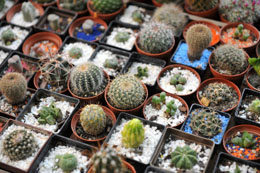Succulent house plants are the best suited for indoor growing as they require low maintenance and care. Read this article to know more about their types and other specifications.

What kind of thoughts started penetrating your mind when you first heard the term succulent house plants? I am sure it must be something very juicy. This is exactly what succulent means, something full of juice or stuffed with moisture, and this is their defining characteristic. Succulents are one of the most efficient types of house plants that retain water in their fleshy leaves, roots, and pockets. Well-known examples of these type of plants are the various varieties of cacti. They are excellent indoor ornamental plants that require minimum maintenance and care. These plants come in a variety of shapes, sizes, colors, and types. These plants very easily survive in the desert due to the water stored in their fleshy leaves, and are adaptable to climate change as well. They can even tolerate a very high temperature during the day and a low temperature at night.
Succulents propagate quite easily, and you do not need to go to the nursery again to get another plant for yourself. You just have to take a piece of it and carefully replant it following the proper methods for planting. This simplicity of succulents makes them excellent house and office plants.
Common Succulent Plants
- Jade Plant (Crassula ovata):
It is also called money tree, friendship tree, or lucky plant. This plant has a bunch of stout leaves that are dark in color, with beautiful small flowers that blossom mostly in spring. During winters, jade needs water just once a month. But in summers, it needs water after every two weeks. This plant should only be pruned in spring.
- Ponytail Palm (Beaucarnea recuvata):
It looks similar to a palm tree, but is shorter in height. It does not grow well on windowsills, rather it should be planted at a distance of a few feet. In summers, it requires water every three weeks and one or two times in winters. The leaves grow more than 2 feet indoors and more than 20 feet if planted outdoor.
- Aloe (Aloe vera):
The most well-known species in the Aloe genus is Aloe vera, which is popular for its medicinal benefits. It requires water only once a week and lesser sunlight in comparison to Jade plant and Ponytail palm. It grows maximum up to eight inches, which is quite manageable for indoor plants. It has spines similar to cactus, but is not at all prickly.
Care
Before we talk about how to care for these plants, let us first try to learn about identifying them. Keep in mind that all succulents are not cacti, but all cacti are succulents. In other words, cacti are a subset of succulent plants, but not the other way round. The plant can also be identified by its thick fleshy leaves that retain water and spines that are mostly not sharp or prickly.
As said earlier, these plants require the least maintenance. They require water occasionally, and even regular pruning is not necessary. But the most essential requirement of this plant is sunlight, so it should be preferably kept outside on the porch or around a window, where it receives sufficient sunlight. Their lifespan is quite long, and they self-feed at times if not provided with water for a long time. The water should be given to the plants once the soil has dried up completely, as excess of it may rot the roots or create a suitable environment for fungi to destroy your plant.
So many benefits and less maintenance make these plants one of the favorites of not only gardeners, but also of housewives. If you are planning to have a succulent species as the primary plant of your landscape, then it will definitely look beautiful, save your money on water, and also contribute towards conserving this precious resource.






 What kind of thoughts started penetrating your mind when you first heard the term succulent house plants? I am sure it must be something very juicy. This is exactly what succulent means, something full of juice or stuffed with moisture, and this is their defining characteristic. Succulents are one of the most efficient types of house plants that retain water in their fleshy leaves, roots, and pockets. Well-known examples of these type of plants are the various varieties of cacti. They are excellent indoor ornamental plants that require minimum maintenance and care. These plants come in a variety of shapes, sizes, colors, and types. These plants very easily survive in the desert due to the water stored in their fleshy leaves, and are adaptable to climate change as well. They can even tolerate a very high temperature during the day and a low temperature at night.
What kind of thoughts started penetrating your mind when you first heard the term succulent house plants? I am sure it must be something very juicy. This is exactly what succulent means, something full of juice or stuffed with moisture, and this is their defining characteristic. Succulents are one of the most efficient types of house plants that retain water in their fleshy leaves, roots, and pockets. Well-known examples of these type of plants are the various varieties of cacti. They are excellent indoor ornamental plants that require minimum maintenance and care. These plants come in a variety of shapes, sizes, colors, and types. These plants very easily survive in the desert due to the water stored in their fleshy leaves, and are adaptable to climate change as well. They can even tolerate a very high temperature during the day and a low temperature at night.